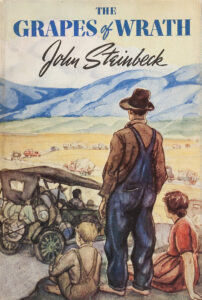 The first time I encountered the name “Rose of Sharon,” it was spelled Rosasharn and pronounced exactly as it looks. If you’ve read “The Grapes of Wrath,” you know who I’m talking about. Rosasharn was the 18-year-old eldest daughter of the Joad family, shallow and self-absorbed when her family began their ill-fated 1930s trek from the Dust Bowl of Oklahoma to the hoped-for land of milk and honey in California.
The first time I encountered the name “Rose of Sharon,” it was spelled Rosasharn and pronounced exactly as it looks. If you’ve read “The Grapes of Wrath,” you know who I’m talking about. Rosasharn was the 18-year-old eldest daughter of the Joad family, shallow and self-absorbed when her family began their ill-fated 1930s trek from the Dust Bowl of Oklahoma to the hoped-for land of milk and honey in California.
My eleventh grade English teacher explained that the name Rose of Sharon came from the Bible book Song of Solomon. The first verse of the second chapter says this: “I am a rose of Sharon, a lily of the valleys.” Sharon is the Hebrew word for a level place and most likely refers to the fertile plain along the Mediterranean coast in western Israel. It was known for its beautiful flowers, though it’s unlikely that they were anything like the Rose of Sharon that grows today in the United States.
Rose of Sharon isn’t a rose at all. It’s a type of hibiscus often thought of as a quintessential Southern plant, though it actually grows from central Florida all the way to the upper mid-west and to some parts of New England. Its showy trumpet-shaped flowers bloom from mid-summer into fall and come in many colors. Rose of Sharon bushes can grow to be 16 feet tall and ten feet wide and are easy for beginning gardeners to grow because they are tolerant of poor soil, heat, humidity and drought.
What’s not to like about that?
When I moved into a new-to-me house seven years ago, I was surprised to discover several Rose of Sharon bushes growing in the deep shade of my back yard. They were tall and spindly and ugly, almost certainly because Rose of Sharon requires at least six hour of sun per day to thrive. The roots were too massive to dig up, so I cut the bushes down instead. Happily, some of the seeds found their way to sunny areas of my yard. I now have a white Rose-of-Sharon, a pale lavender one, and another—color unknown—that hasn’t burst into bloom yet. I can’t wait to see what it turns out to be.
But back to Rosasharn Joad. Decades had passed between my first reading of John Steinbeck’s 1939 classic, which was awarded both the Pulitzer Prize and the National Book Award, and the time when I picked it up again. The re-read happened on a long plane ride. The passenger seated next to me worked Sudoku puzzles and watched a movie on her phone and didn’t strike up a conversation until we touched down and I placed my bookmark in “The Grapes of Wrath” and closed it. Then she said, “I just want you to know I’m going to get myself a copy of that book and read it as soon as I get home. I haven’t read it since high school.”
“You should,” I told her. “You definitely should.”
I like to recount that story whenever someone tells me how much they adored “The Four Winds” by Kristin Hannah. I read that novel, too, and found it to be a second-rate retelling of the story of hardworking people thrust into unimaginable poverty during the Great Depression. But if Hannah is more your cup of tea than Steinbeck, go for it. Reading anything about those hard, hard times is a million times better than reading nothing.
Those who forego “The Grapes of Wrath” will, however, miss out on perhaps the most unforgettable and controversial final scene in all of American literature. It’s a scene in which Rosasharn, who has just given birth to “a blue shriveled little mummy that never breathed,” becomes one of the novel’s many heroes.
I’m honored to have flowers that share her name growing in my yard.
(July 13, 2022)